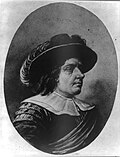
The territory which would later become the state of New York was settled by European colonists as part of the New Netherland colony (parts of present-day New York, New Jersey, Connecticut and Delaware) under the command of the Dutch West India Company in the Seventeenth Century. These colonists were largely of Dutch, Flemish, Walloon, and German stock, but the colony soon became a "melting pot." In 1664, at the onset of the Second Anglo-Dutch War, English forces under Richard Nicolls ousted the Dutch from control of New Netherland, and the territory became part of several different English colonies. Despite one brief year when the Dutch retook the colony (1673–1674), New York would remain an English and later British possession until the American colonies declared independence in 1776.
Contents
- Dutch Era of New Netherland (1624–1664; 1673–1674)
- Restoration of the colony, 1673–1674
- Under British control (1664–1673; 1674–1783)
- See also
- Bibliography
- References
- External links
With the unification of the two proprietary colonies of East Jersey and West Jersey in 1702, the provinces of New York and the neighboring colony New Jersey shared a royal governor. This arrangement began with the appointment of Queen Anne's cousin, Edward Hyde, Lord Cornbury as Royal Governor of New York and New Jersey in 1702, and ended when New Jersey was granted its own governor in 1738.

























